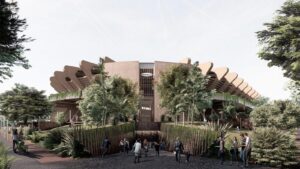Homely objets d’art at the Woollahra Small Sculpture Prize
As any model-making student of architecture can attest to, the sheer physicality of the design process is crucial for both understanding and inspiration. Sculpture, for these reasons, has long held a special place in the hearts of architects and interior designers – not to mention design hunters looking to spatially enliven a residential setting.
This year, Woollahra Gallery at Redleaf again plays host to the prestigious Woollahra Small Sculpture Prize. The criteria are simple, and refreshingly open-ended: any material and any theme so long as the object extends no more than 80cm in any dimension. With over 600 entries, this openness has created an intriguing mix amongst the 50 sculptures on display. The exhibition itself runs in Sydney from September 28 to November 5.
The $25,000 prize is awarded on the basis of a blind selection process by a panel of judges comprising Alex Seton, sculptor and 2009 Woollahra Small Sculpture Prize winner, Blak Douglas, artist and Archibald Prize winner, and Dr Kate Harrison, chair of the Copyright Agency.
Alex Seton
Blak Douglas
Dr. Kate Harrison
The winner of the 2023 Woollahra Small Sculpture Prize has been announced as Anita Johnson for her work, Tenderness. It’s made from a salvaged cricket ball, moulded and dyed leather, linen thread and possum fur. When Johnson found the ball in a state of ruin, she was drawn to the vulnerability of its wounded form.
By taking a cast of her breast and using it to wet mould leather, an ‘object-prosthetic’ was produced. Possum fur – a sculptural nod to Meret Oppenheim and the possum skin blankets of her own youth – enhances the sense of comfort further still. The cricket ball, repaired in this manner, reveals compassion and tenderness in the wake of violence.
“A mark of success for us would be if a first-time collector or member of the public comes in and falls in love with a piece,” says gallery director, Pippa Mott. “I think that’s a really special thing and we see it a lot. Paintings can go on a wall but sculpture feels like the next level of investment – it’s about building the next generation of collectors and opening people’s eyes to the possibilities of sculpture in a space.”
With all exhibition items on sale, that space might be residential and intimate or on a full commercial scale. The objects on display range from the beautiful, decorative or strange to the political. A number of works, for example, directly tackle issues relating to the climate crisis.
Jamie North, for instance, explores the impact of human activity on the natural world with his work, Remainder No.52. It’s part of a series of sculptural spheres representing an amalgam of industrial by-products in various states of erosion and encompassing an almost parasitic growth of flora.
Elsewhere, a room is given over to objects that all in some way relate to Indigenous themes. Kyra Mancktelow’s works, for example, investigate the legacies of colonialism and pose questions about how we remember and acknowledge Indigenous histories. Gubagulabu (Y1805) adopts traditional Quandamooka weaving techniques that were once considered lost, and casts it in bronze to have it immortalised for First Nations generations to come.
“If the artist walks in and feels that we’ve done justice to their work, then I’d be very happy,” says Mott. “We are also a heritage building, so there’s a significant architectural context to deal with as the environment within which the works are nestled.”
The gallery itself sits within a wider site whose design history stretches back to 1863. Most recently, a library occupied the space before being restored and reinvented as an exhibition space by Tanner Kibble Denton Architects in 2001.
Judges Blak Douglas and Alex Seton with gallery director Pippa Mott (centre) with winning work, Tenderness, photograph by Havard Sagen.
“Commendations to all entrants this year and with such an entertaining variety of media, form and verbal commentary,” says Douglas. “The honour of perusing all works has reinforced great faith in the contemporary sculptural landscape here today.”
Seton, meanwhile, comments: “I was very impressed with how much the works were a cross-section of contemporary issues. There were many entries that reflected serious concerns about the environment, from the recent bushfires to the health and respect for flora and fauna in the face of environmental pollution and climate crisis. Other surprisingly popular themes centred around housing and the built environment.”
Finally, Dr Harrison adds: “Selecting the final entries was difficult. So many of the sculptures were striking in their originality and creativity, their strength of concept, or their materials and design.”
The Woollahra Small Sculpture Prize 2023 runs at Woollahra Gallery at Redleaf from September 28 to November 5.
Woollahra Small Sculpture Prize
woollahragallery.com.au
The post Homely objets d’art at the Woollahra Small Sculpture Prize appeared first on Habitusliving.com.

As any model-making student of architecture can attest to, the sheer physicality of the design process is crucial for both understanding and inspiration. Sculpture, for these reasons, has long held a special place in the hearts of architects and interior designers – not to mention design hunters looking to spatially enliven a residential setting.
This year, Woollahra Gallery at Redleaf again plays host to the prestigious Woollahra Small Sculpture Prize. The criteria are simple, and refreshingly open-ended: any material and any theme so long as the object extends no more than 80cm in any dimension. With over 600 entries, this openness has created an intriguing mix amongst the 50 sculptures on display. The exhibition itself runs in Sydney from September 28 to November 5.
The $25,000 prize is awarded on the basis of a blind selection process by a panel of judges comprising Alex Seton, sculptor and 2009 Woollahra Small Sculpture Prize winner, Blak Douglas, artist and Archibald Prize winner, and Dr Kate Harrison, chair of the Copyright Agency.
Alex Seton
Blak Douglas
Dr. Kate Harrison
The winner of the 2023 Woollahra Small Sculpture Prize has been announced as Anita Johnson for her work, Tenderness. It’s made from a salvaged cricket ball, moulded and dyed leather, linen thread and possum fur. When Johnson found the ball in a state of ruin, she was drawn to the vulnerability of its wounded form.
By taking a cast of her breast and using it to wet mould leather, an ‘object-prosthetic’ was produced. Possum fur – a sculptural nod to Meret Oppenheim and the possum skin blankets of her own youth – enhances the sense of comfort further still. The cricket ball, repaired in this manner, reveals compassion and tenderness in the wake of violence.
“A mark of success for us would be if a first-time collector or member of the public comes in and falls in love with a piece,” says gallery director, Pippa Mott. “I think that’s a really special thing and we see it a lot. Paintings can go on a wall but sculpture feels like the next level of investment – it’s about building the next generation of collectors and opening people’s eyes to the possibilities of sculpture in a space.”
With all exhibition items on sale, that space might be residential and intimate or on a full commercial scale. The objects on display range from the beautiful, decorative or strange to the political. A number of works, for example, directly tackle issues relating to the climate crisis.
Jamie North, for instance, explores the impact of human activity on the natural world with his work, Remainder No.52. It’s part of a series of sculptural spheres representing an amalgam of industrial by-products in various states of erosion and encompassing an almost parasitic growth of flora.
Elsewhere, a room is given over to objects that all in some way relate to Indigenous themes. Kyra Mancktelow’s works, for example, investigate the legacies of colonialism and pose questions about how we remember and acknowledge Indigenous histories. Gubagulabu (Y1805) adopts traditional Quandamooka weaving techniques that were once considered lost, and casts it in bronze to have it immortalised for First Nations generations to come.
“If the artist walks in and feels that we’ve done justice to their work, then I’d be very happy,” says Mott. “We are also a heritage building, so there’s a significant architectural context to deal with as the environment within which the works are nestled.”
The gallery itself sits within a wider site whose design history stretches back to 1863. Most recently, a library occupied the space before being restored and reinvented as an exhibition space by Tanner Kibble Denton Architects in 2001.
Judges Blak Douglas and Alex Seton with gallery director Pippa Mott (centre) with winning work, Tenderness, photograph by Havard Sagen.
“Commendations to all entrants this year and with such an entertaining variety of media, form and verbal commentary,” says Douglas. “The honour of perusing all works has reinforced great faith in the contemporary sculptural landscape here today.”
Seton, meanwhile, comments: “I was very impressed with how much the works were a cross-section of contemporary issues. There were many entries that reflected serious concerns about the environment, from the recent bushfires to the health and respect for flora and fauna in the face of environmental pollution and climate crisis. Other surprisingly popular themes centred around housing and the built environment.”
Finally, Dr Harrison adds: “Selecting the final entries was difficult. So many of the sculptures were striking in their originality and creativity, their strength of concept, or their materials and design.”
The Woollahra Small Sculpture Prize 2023 runs at Woollahra Gallery at Redleaf from September 28 to November 5.
Woollahra Small Sculpture Prize
woollahragallery.com.au
The post Homely objets d’art at the Woollahra Small Sculpture Prize appeared first on Habitusliving.com.





